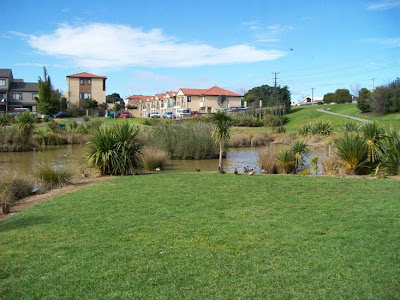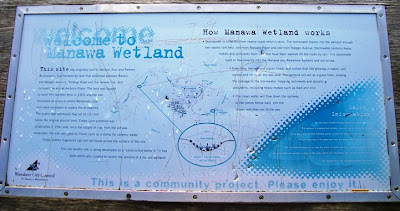Back when I did the "community illustrated" post on Titirangi's library pavers, Cat B wrote in the comments:
"There are also mosaic pavers at the Margan Ave duck ponds in New Lynn, each one is made with Crown Lynn bits."
Well, Cat, it takes me a bit of a while to get around to these places (me with shanks' pony and all) but -- I usually get around to them eventually. Last Sunday, feeling determined to get some air into the lungs and sun in my bones after a bit of the winter sniffles, coughs and blues -- I headed out.
Manawa Wetland off Margan Avenue is a place I've visited in history before now. What the signs won't tell you is that before this was a dump for Crown Lynn rejects, before the clay was scoured out for bricks and pots and what-have-you -- it was the site of the poudrette factory, and before that, it was New Lynn's Waterfalls Estate in the 1860s.
From DI 9A.416, LINZ records, Crown Copyright.
The wetland is well signposted with boards relating the story of the regeneration back in 2000.
"This site was originally part of Gardner Bros and Parkers Brickworks -- five hectares of land that stretched Rankin and Margan Avenues, Titirangi Road and the railway line, and included the kiln at Ambrico Place. The land was bought by local firm Gardner Bros in 1902 and the site developed as a quarry where Waitemata clay soils were excavated to supply the brickworks. The quarry was eventually dug out to 12-15m below the original ground level. Crown Lynn potteries was established in 1941 and once the supply from the pit was exhausted, the site was used by Crown Lynn as a dump for ceramic waste. Today pottery fragments can still be found across the surface of the site.
"This old landfill site is being developed as a 'constructed wetland'. It has been artificially created to mimic the actions of a natural wetland."
This is part of the ceramic tiling project undertaken in late 2000 by Richard Parker, Janet Holtriger, and a cast of 400 members of the community.
In 2007, the wetland needed work to clear weeds and restore health to the ponds. This page from Wetland Solutions describes how it was, and how it has come to be.
The park has even won environmental awards. Pity the sign saying that is in such sad shape.
All in all, though, this is a place loved by the local community who come to walk the walks, feed the ducks, "adopt" pukekos and go off to find those bits of old pottery rubbish we now value highly as part of our local heritage.














Ahhhh yes indeed it is our favourite place to visit with our two young kids.
ReplyDeleteThanks for telling us about it, Cat.
ReplyDeleteThanks for the info. I have just started to explore this area.
ReplyDelete